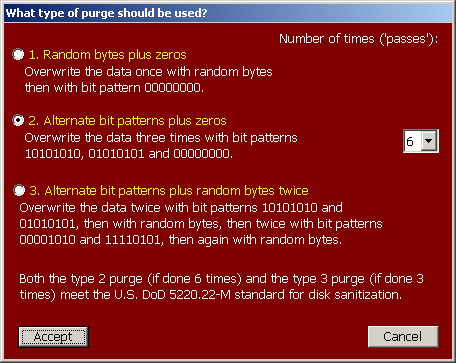| Data Destroyer |
| Types of purge |
When Data Destroyer purges a file, that file is overwritten several (or many) times before it is deleted. The software provides three ways of purging data, and you can specify how many times a file is to be overwritten.

The data can be overwritten:
- From once to nine times (2 to 18 overwrites) with random bytes then zero bytes.
- From once to eight times (3 to 24 overwrites) using bytes with alternating bit patterns
then zero bytes
- 10101010 (hexadecimal AA)
- 01010101 (hexadecimal 55)
- 00000000 (hexadecimal 00)
- From once to four times (6 to 24 overwrites) first using bytes with alternating bit patterns:
- 10101010 (hexadecimal AA)
- 01010101 (hexadecimal 55)
- 00001010 (hexadecimal 0A)
- 11110101 (hexadecimal F5)
For a more thorough destruction of the data you can use method 1 with six passes, method 2 with four passes or method 3 with two passes. Each of these will overwrite the data twelve times.
The larger the number of overwrites the less likely it is that special data recovery tools can recover the data. With eighteen or more overwrites it is very unlikely that any data can be recovered by such tools.
To erase the bit patterns in a disk file it is necessary to use multiple overwrites which actually affect the magnetic material on the disk; performing multiple overwrites which are simply written to a memory buffer is ineffective. Thus Data Destroyer file overwrites are done using low-level disk write functions so that the bytes are actually written to disk for each overwrite, not just to a disk cache in memory. (If some allegedly secure file deletion software does not say that each overwrite is to the disk, and not simply to the disk cache, then beware, since in that case many alleged overwrites may actually amount only to a single overwrite.)
The United States Department of Defense has set standards for "sanitizing" hard disks by overwriting:
Overwriting is an approved method for sanitization of hard disk storage media containing unclassified data. Overwriting of data means replacing previously stored data on a drive or disk with a predetermined pattern of meaningless information. This effectively renders the data unrecoverable, but the process must be correctly understood and carefully implemented. Overwriting consists of recording data onto magnetic media by writing a pattern of fluxes or pole changes that represent binary ones (1) and zeros (0). These patterns can then be read back and interpreted as individual bits, 8 of which are used to represent a byte or character. If the data is properly overwritten with a pattern (e.g., "11111111" followed by "00000000") the magnetic fluxes will be physically changed and the drives read/write heads will only detect the new pattern and the previous data will be effectively erased. To purge the hard drive, the DoD requires overwriting with a pattern, and then its complement, and finally with another pattern (e.g., overwrite first with "00110101", followed by "11001010", then "10010111"). Sanitization is not complete until all six passes of the three cycles are completed.
According to this standard, choice of either a type 2 purge performed six times (for 18 overwrites) or a type 3 purge performed three times (for 18 overwrites), will result in an acceptable degree of "sanitization".
| Next: Anti-Malware Software | |
| Data Destroyer Main Page | Hermetic Systems Home Page |